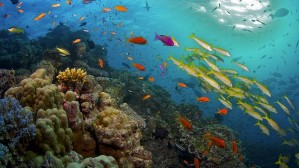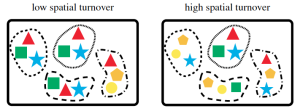 While still ostensibly ‘on leave’ (side note: Does any scientist really ever take a proper holiday? Perhaps a subject for a future blog post), I cannot resist the temptation to blog about our lab’s latest paper that just came online today. In particular, I am particularly proud of Dr Camille Mellin, lead author of the study and all-round kick-arse quantitative ecologist, who has outdone herself on this one.
While still ostensibly ‘on leave’ (side note: Does any scientist really ever take a proper holiday? Perhaps a subject for a future blog post), I cannot resist the temptation to blog about our lab’s latest paper that just came online today. In particular, I am particularly proud of Dr Camille Mellin, lead author of the study and all-round kick-arse quantitative ecologist, who has outdone herself on this one.
Today’s subject is one I’ve touched on before, but to my knowledge, the relationship between ‘diversity’ (simply put, ‘more species’) and ecosystem resilience (i.e., resisting extinction) has never been demonstrated so elegantly. Not only is the study elegant (admission: I am a co-author and therefore my opinion is likely to be biased toward the positive), it demonstrates the biodiversity-stability hypothesis in a natural setting (not experimental) over a range of thousands of kilometres. Finally, there’s an interesting little twist at the end demonstrating yet again that ecology is more complex than rocket science.
Despite a legacy of debate, the so-called diversity-stability hypothesis is now a widely used rule of thumb, and its even implicit in most conservation planning tools (i.e., set aside areas with more species because we assume more is better). Why should ‘more’ be ‘better’? Well, when a lot of species are interacting and competing in an ecosystem, the ‘average’ interactions that any one species experiences are likely to be weaker than in a simpler, less diverse system. When there are a lot of different niches occupied by different species, we also expect different responses to environmental fluctuations among the community, meaning that some species inherently do better than others depending on the specific disturbance. Species-rich systems also tend to have more of what we call ‘functional redundancy‘, meaning that if one species providing an essential ecosystem function (e.g., like predation) goes extinct, there’s another, similar species ready to take its place.
The evidence is out there, so why am I so chuffed about our latest paper? Much of the past evidence has focussed solely on alpha diversity (a simple inventory of how many species are in a particular location), which is not often a great measure of biodiversity. Indeed, using alpha diversity to quantify the diversity-stability hypothesis is potentially problematic because sampling problems mean that ‘missed’ (undetected) species might degrade the true underlying relationship.
 Instead, we used a measure of species ‘turnover’ (beta diversity), which has been largely overlooked in the past, to determine whether the relationship was supported broadly across an entire landscape – in this case, the entire breadth of Australia’s Great Barrier Reef. Based on the hypothesis that greater beta diversity should lead to a wider range of responses to environmental fluctuations over time, there should be a stabilisation in the entire community, with fewer invasions, disease events or die-offs from extreme climatic events. Examining reef fish beta diversity across the Reef, we show that across most species groups, greater spatial turnover leads to lower temporal fluctuations in abundance over 16 years of data collection.
Instead, we used a measure of species ‘turnover’ (beta diversity), which has been largely overlooked in the past, to determine whether the relationship was supported broadly across an entire landscape – in this case, the entire breadth of Australia’s Great Barrier Reef. Based on the hypothesis that greater beta diversity should lead to a wider range of responses to environmental fluctuations over time, there should be a stabilisation in the entire community, with fewer invasions, disease events or die-offs from extreme climatic events. Examining reef fish beta diversity across the Reef, we show that across most species groups, greater spatial turnover leads to lower temporal fluctuations in abundance over 16 years of data collection.
For the sticklers amongst you, we did also use several different metrics of spatial and temporal turnover, and we controlled for any potential alpha diversity sampling artefacts and scale dependencies. In essence, the relationship is robust, meaning that the more fish species out there (well, the faster communities change in constituent species as you move horizontally across the Reef), the less likely they are to fluctuate in population size over time, meaning that there is a lower likelihood of going extinct.
Now for that enticing anomaly I mentioned earlier – in what situation(s) did the relationship not follow expectations? Although it generally held true when we looked at all species groups together, we did find that for one family of fishes (the Acanthuridae surgeonfishes) the relationship was reversed! In other words, when there was high surgeonfish turnover, there was MORE temporal fluctuation in abundance.
How could this be? Well, surgeonfishes are highly mobile roving grazers of seaweeds that can respond quickly to changes in resources. As such, they are good opportunists that can swoop in and change the entire coral reef structure by munching away the colonising algae, thereby increasing the niches available for other fish. This ‘roving grazer’ life history makes them a key component of many near-shore coral reefs exposed to high environmental variability.
Finally, we also tested the expectation that areas conserved for their species richness in the Great Barrier Reef would generally have lower temporal fluctuation (i.e., greater resilience), as is assumed under most reserve-selection criteria. While spatial turnover was indeed higher in protected areas, temporal turnover was only slightly lower in these for all species considered. As expected, surgeonfish turnover was actually higher in protected areas. This means that protected areas are in general doing their intended job, but not necessarily for all species.
I think that’s enough to whet the appetite, but do read the article for more juicy ecological meat if you’re keen. Back to my ‘holiday’.



[…] resilience of a system can be enhanced by a number of factors, including its diversity, the interconnectedness of its diverse elements, and how much capital it has (including […]
LikeLike
[…] The resilience of a system can be enhanced by a number of factors, including its diversity, the interconnectedness of its diverse elements, and how much capital it has (including […]
LikeLike
[…] for the entire system, for most ecosystems possess some form of resilience derived from node redundancy of ecological function. So focussing on the entirely to the complex system might in fact miss the […]
LikeLike
[…] that biotic diversity contributes to risk management. For example, there is a relationship between diversity and ecosystem resilience. The more diverse an ecosystem, the more likely it is that at least some of it’s members are […]
LikeLike
[…] higher biodiversity (both in terms of total number of species, phylogenetic diversity, as well as species turnover) imparts greater disease resistance, lower invasibility, higher productivity, lower temporal […]
LikeLike
[…] of publishing with Marc Cadotte, and his wonderful body of work — including this paper — has inspired me greatly. A product of the great Tilman lab, Marc shows how (in his words): “… communities […]
LikeLike
[…] drastic changes and a greater ability to recover after disturbances (see a wonderful article here https://conservationbytes.com/2014/01/08/more-species-more-resilience/ for some solid reading). This consensus comes at a time when buzz words like “sustainability” […]
LikeLike
[…] https://conservationbytes.com/2014/01/08/more-species-more-resilience/ […]
LikeLike
Thanks for the affirmation. I tweeted, pinned, and scooped it. See it at http://scoop.it/t/ecoscifi.
LikeLike
[…] Why more biodiversity = more ecosystem resilience: the definitive takeout? (Conservation Bytes) […]
LikeLike